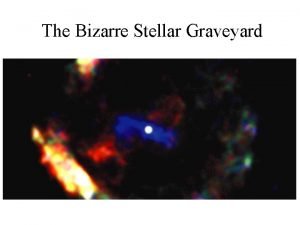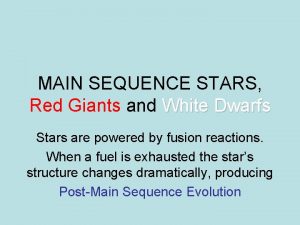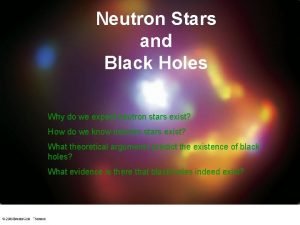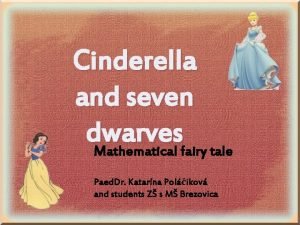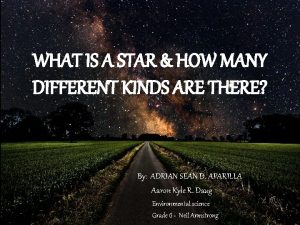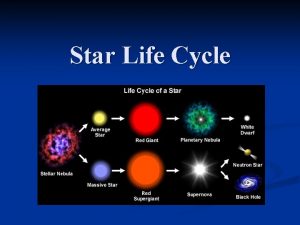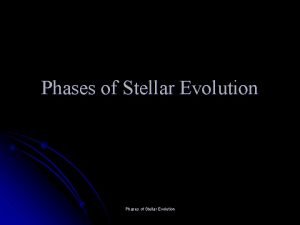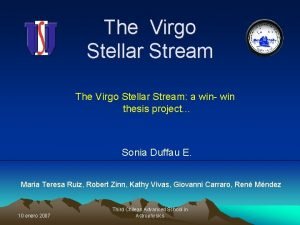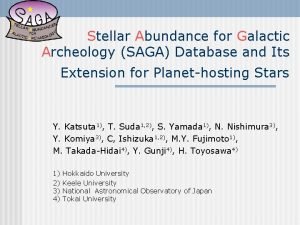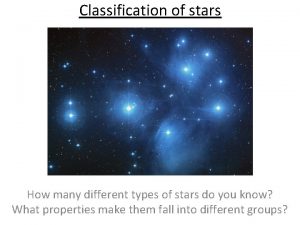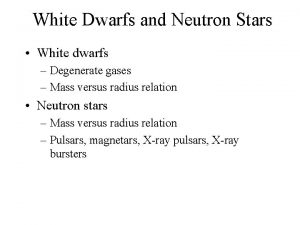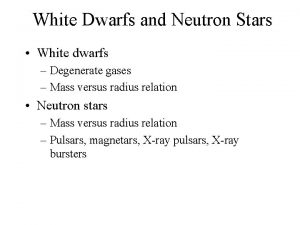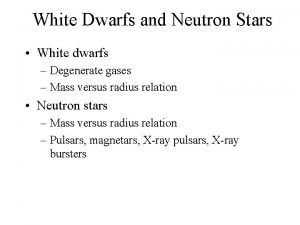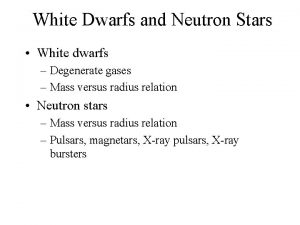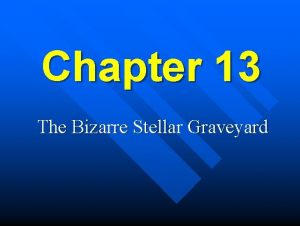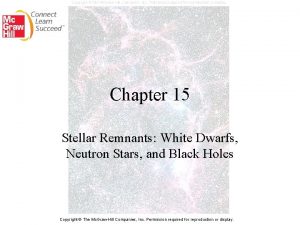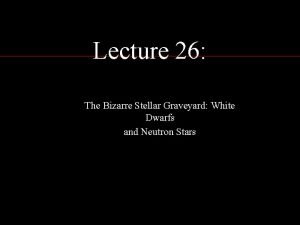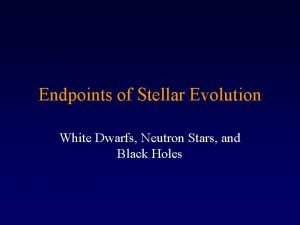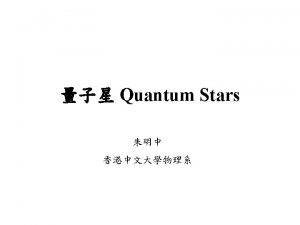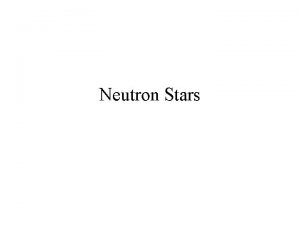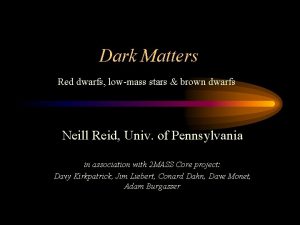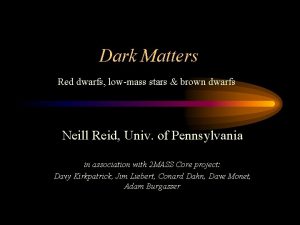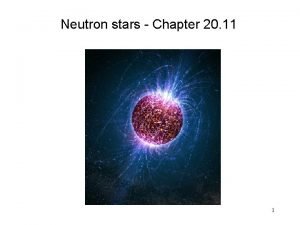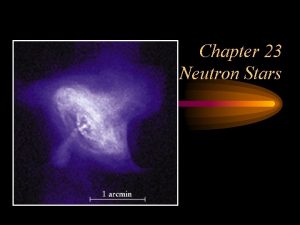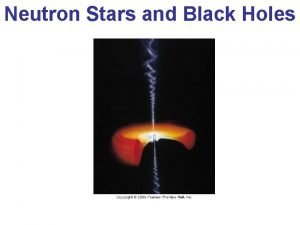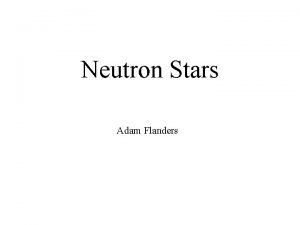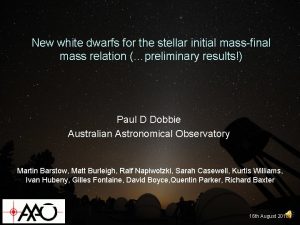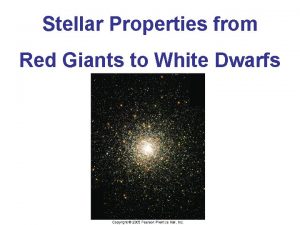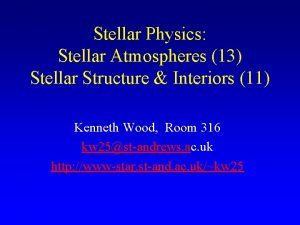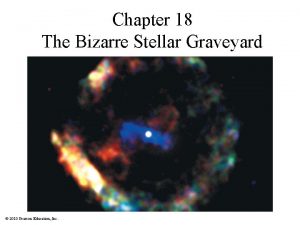Chapter 15 Stellar Graveyard White Dwarfs Neutron Stars
























- Slides: 24

Chapter 15: Stellar Graveyard White Dwarfs Neutron Stars Black Holes Gamma-Ray Bursts

15. 1 Degenerate Objects • Objects made of degenerate matter (plasma conditions dominated by degeneracy pressure). • White dwarfs are supported by electron degeneracy pressure. • Neutron stars are supported by neutron degeneracy pressure. • When gravity is stronger than neutron degeneracy pressure => black hole.

15. 2 White Dwarfs • WDs have sizes similar to terrestrial planets. • A pair of dice made of degenerate electron matter would weight about 5 tons on Earth. • WD composition reflects the products of the star’s final burning stage. • Intermediate-mass stars yield WDs made of oxygen and heavier elements. • 1 MSun stars leave behind a WD made mostly of carbon. • Very low-mass stars leave behind He WDs.

The White Dwarf Limit • Electron speeds are higher in more massive WDs. • At 1. 4 MSun the e- speeds approach c. Their speed cannot increase and they cannot resist the crush of gravity. This is the Chandrasekhar limit to a WD mass. • All WDs with observed masses comply.

WDs in Close Binary Systems • WDs in close binary systems can gain matter from a companion through an accretion disk. • Particles in the disk obey Kepler’s laws. Inner parts move faster than outer parts creating friction and heating. • Particle orbits become smaller and smaller until they fall onto the WD.

Novae • Dwarf nova: sudden increase in brightness by ~factor 10 due to enhanced accretion (disk instability). • Nova: Thermonuclear flash of H-shell burning. L~105 LSun. • Nova recur each 102104 years.

White Dwarf Supernovae • Despite of novae outbursts, accreting WDs gain net mass until they reach the 1. 4 MSun limit. • When gravity overcomes electron degeneracy, WD collapses until the temperature reaches the threshold of C fusion. • C ignites throughout the WD, making it explode into a WD supernova (Type Ia). • The supernova shines with L~1010 LSun. • No remnant results from a Type Ia supernova.

Type Ia versus Type Ib and II SN • WDs contain little H. • Massive stars have plenty of H. • The spectra and light curves of Type Ia SN are different than those of Type Ib and II SN. • Type Ia SN are one of the primary means to measure large distances in the universe.

Homework 3 • Two stars, p and s, in a binary system are of the same size. “s” has spectral type F, while “p” has spectral type B. Which one is more luminous? • Imagine that you are plunging into the Sun, starting from Earth. Briefly describe what you will see as you descend. • Earth is ~15 x 107 km from the Sun, and the apparent solar brightness in our sky is 1, 300 watts per m 2. Determine the apparent solar brightness if we moved 5 times closer to our star.

Neutron Stars • Basic properties: (1) size ~ 10 km, mass ~ 1. 4 -3 MSun (2) Density similar to atomic nucleus (3) Made of neutrons (4) Gravity bound, vesc~c/2, gravitational redshift (5) origin in massive star supernova.

Little Green Men! • October-November 1967, Jodrell Bank radiotelescope, graduate student Jocelyn Bell and Dr. Anthony Hewish discover a strong source of radio waves in Cygnus pulsating with a period of 1. 337301 s. As precise as atomic clocks. • The mysterious source of radio emission was dubbed LGM for a while.

Pulsars • Pulsars are found at the center of some SN remnants such as the crab. • The period of the Crab’s pulsar is 0. 033 s. • Pulsars are fast spinning neutron stars left behind a supernova explosion.

The Lighthouse Model for Pulsars • The collapse of the iron core makes a fast rotating neutron star with a strong magnetic field. • The magnetic field directs intense beams of radiation along the magnetic poles. • The beams of radiation sweep past the line of sight again and again.

More on Pulsars • Pulsars slow down because of the angular momentum carried away by the beamed particles. • The spinning periods of pulsars are observed to increase. • Only an object as dense and small as a neutron star can spin so fast.

Neutron Stars in Close Binaries • As WDs, neutron stars can accrete mass from a stellar companion. • Infalling matter onto a NS releases a large amount of gravitational energy. • The accretion disks around NSs are very hot. • Her X-1 is an eclipsing Xray binary. • X-ray bursters release ~105 LSun in a few s.

Black Holes • A neutron star’s mass cannot exceed ~3 MSun because gravity overcomes neutron degeneracy pressure. • Laplace & Mitchell speculated about objects so compact that vesc>c. • A BH can be thought of as a region in which spacetime is curved so much that it becomes a bottomless pit.

Black Hole Size • The boundary of a BH is called the event horizon. Information can never reach us from events inside it. • Karl Schwarzschild computed the radius of the event horizon in 1916. RS=2 GM/c 2 • Singularity is the point at which all the mass that created the BH resides.

Gravitational Redshift • Einstein’s general theory of relativity predicts that light coming out of a strong gravitational field should show a redshift. • The gravitational redshift increases for more compact objects.

Time Dilation • Another prediction of the general theory of relativity is that time runs more slowly as the force of gravity becomes stronger. • From the point of view of an outside observer, the time it takes for a particle to cross the event horizon becomes infinite.

Tidal Forces • The larger size of supermassive black holes mean that tidal forces are weaker in the event horizon. • It is safer to approach the event horizon of the BH at the center of the Milky Way than to approach a stellar-mass BH.

Evidence for Black Holes • BHs reveal themselves through their effects on the surroundings. • Cyg X-1 contains an Otype star with a mass of 18 MSun and an unseen companion with a mass of 10 MSun. Fast variations in X-ray radiation indicate a small size of the emitting surface.

Gamma-ray Bursts • Discovered by US military satellites in the 1960 s. • In 1991 the Compton gamma-ray observatory detected about 1 event per day coming from all over the sky. • In 1997 an afterglow was observed at other wavelengths. The explosion came from a very distant galaxy.

Hypernovae • Gamma-ray bursts are now routinely observed. • Some evidence indicates that they are related to particularly powerful supernova events (hypernova). • One popular scenario is that gamma-ray bursts originate from bipolar supernova explosions in which one of the jets is beamed toward us.

The Big Picture • Clear astronomical evidence exists for white dwarfs, neutron stars and black holes. • Close binary systems with stellar corpses produce novae, Type Ia supernovae and X-ray bursters. • Black holes warp spacetime around them into a true hole of information. • Gamma-ray bursts are the most energetic explosions in the universe. They could be related to bipolar supernova explosions.
 Masses in the stellar graveyard
Masses in the stellar graveyard Gender roles in snow white and the seven dwarfs
Gender roles in snow white and the seven dwarfs Seven dwarfs once upon a time
Seven dwarfs once upon a time Hydrostatic equilibrium
Hydrostatic equilibrium Neutron star
Neutron star White dwarf neutron star black hole
White dwarf neutron star black hole The rwenzori mountains mary daniels is a student in england
The rwenzori mountains mary daniels is a student in england Como bluff dinosaur graveyard
Como bluff dinosaur graveyard Death imagery in the scarlet ibis
Death imagery in the scarlet ibis Nh old graveyard association
Nh old graveyard association Accessify salford
Accessify salford Bleeding tree symbolism
Bleeding tree symbolism Dwarfs of cinderella
Dwarfs of cinderella Brown dwarf types
Brown dwarf types Atmospheric heaven
Atmospheric heaven Astronomy
Astronomy Stellar evolution diagram
Stellar evolution diagram Zero age main sequence
Zero age main sequence Stellar motion matlab
Stellar motion matlab Virgo stellar
Virgo stellar Stellar evolution lab the life cycle of a star answer key
Stellar evolution lab the life cycle of a star answer key Stellar hosting iptv
Stellar hosting iptv Stellar assessment
Stellar assessment Stellar saga
Stellar saga What is stellar parallax?
What is stellar parallax?
